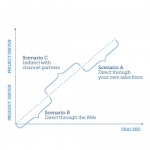What the client wants and what the client needs is not the same
 This post is inspired by my recent reading of Alan Weiss, so let me give him the credit up front.
This post is inspired by my recent reading of Alan Weiss, so let me give him the credit up front.
A conversation with a client often starts like this [small talk and niceties excluded]:
A potential client is on the line. “I have got your name from [reference]. Can you help facilitate a strategy process for us? We need this completed before the end of October so we can use it as the basis for next year’s budget and planning process.”
My reply: “May I ask why you don’t want to continue with the current strategy?” (I assume they have some sort of strategy in place already).
The client: “We can’t do that. We need to do different things going forward, thus we need to revisit the strategy.”
My reply: “Fine, I have the following options for a briefing (I mention a couple of dates and hours).”
The client: “Do we need to meet? I can give a short briefing on the phone and you can make a proposal and quote me a price for the facilitation. I have already talked to other consultants and have their proposals on my desk.”
My reply: “You may want a new strategy now, but what you need are certain and specific results in the future – am I right?”
The client: “Yes, sure – those two go together.”
My reply: “Is it unreasonable that I insist on being thoroughly briefed on your future objectives BEFORE I propose a process for defining the strategy that will enable you to achieve these objectives?”
The client: “I guess not. OK – let’s meet.”
What the client wants
As management consultants, we are constantly exposed to clients asking for the execution of certain activities, deliveries or inputs, although what they really need are business results.
This video is an excellent illustration of what happens every day all over the world when clients and consultants mistake activities for objectives.
“Red parallel and perpendicular lines drawn with transparent ink”, strategy processes, market assessments, focus groups, executive search, partner recruitment, sales training, business modelling, sales capacity in foreign markets and customer satisfaction surveys are examples of such activities. While some of these activities are certainly genuine and perhaps relevant they are merely stepping-stones on the path to achieving measurable results. Other activities could deliver the same or even better results.
What the client needs
 If we do not uncover and understand the relationship between the needed results and the wanted activities, then we have disabled our capability of adding value.
If we do not uncover and understand the relationship between the needed results and the wanted activities, then we have disabled our capability of adding value.
If a management consultant has the ambition of adding true value to his client, then he must help the client achieve measurable results.
By the end of the day, the client is measured on his performance. Performance is measured in revenue growth, profitability, market shares, winning lighthouse references, preparing for attractive exits, increasing productivity etc.
No company undertakes strategy processes, market assessments, focus groups, executive search, partner recruitment, sales training, business modelling, generation of sales capacity in foreign markets and doing customer satisfaction surveys just to tick them off on a to-do list. Maybe someone in the operational ranks has these activities on their performance plans and needs to see them through to the end, but for the executive office, they are instruments for achieving measurable results.
The value-add of the management consultant
The ability to tie activities to the accomplishments of measurable results is the value of the management consultant.
If you merely deliver an activity or an input, then you have not added any measurable value.
It takes a certain breed of person to challenge the clients’ executives on their preconceived ideas for activities required to achieve strategic objectives. However, this is exactly the role of a management consultant. If he or she cannot do this, then the word “management” should be removed from the job title.







